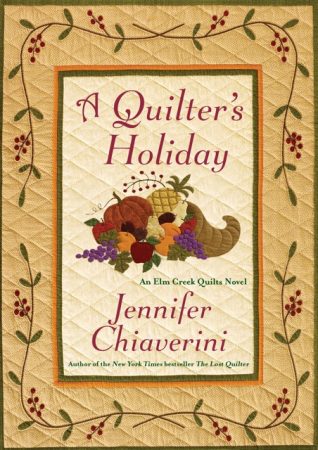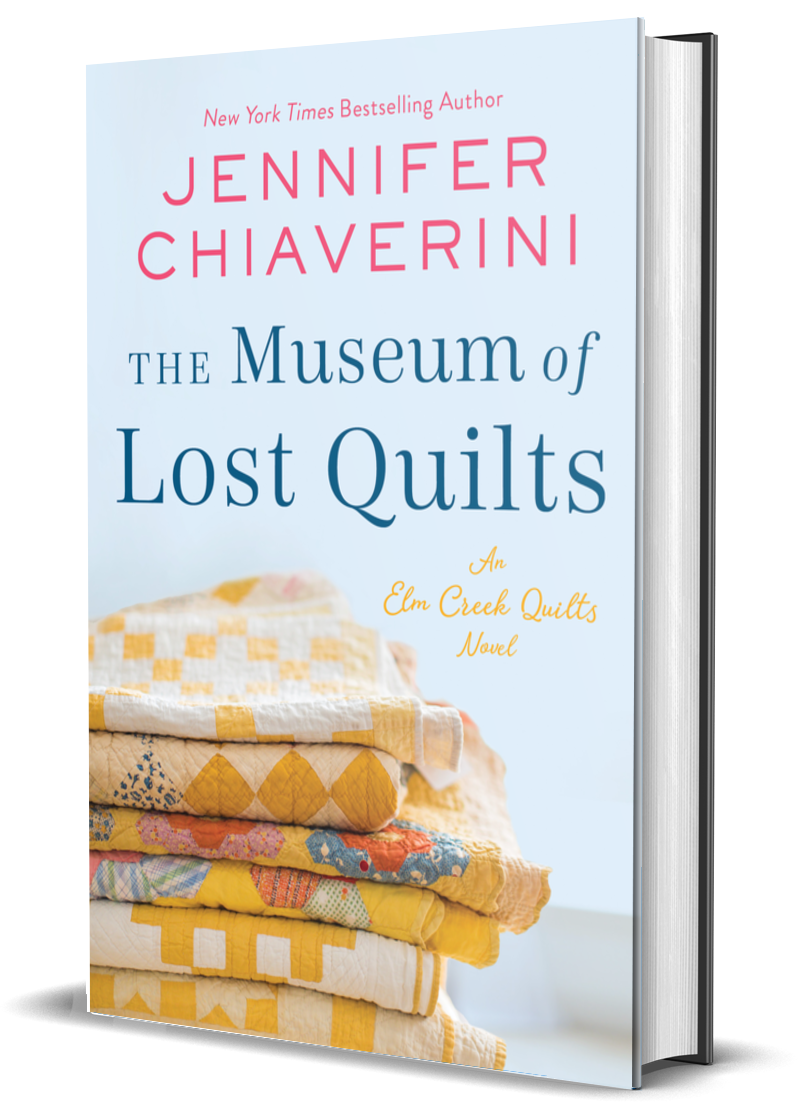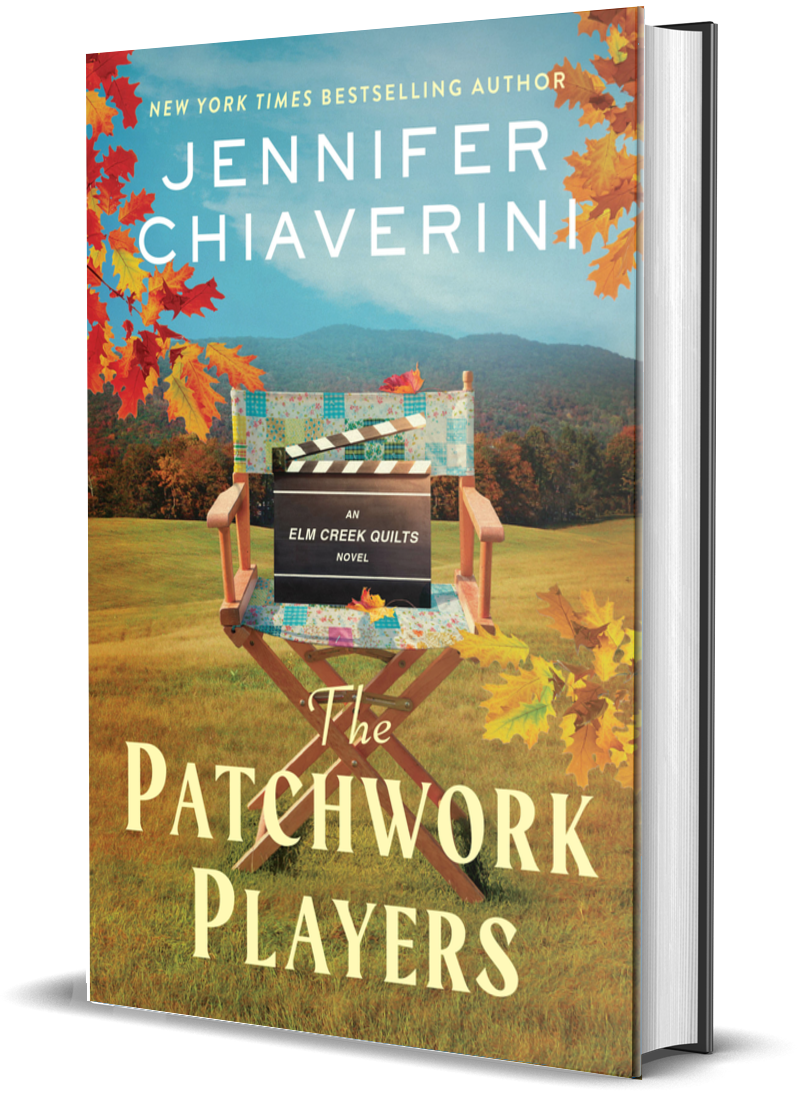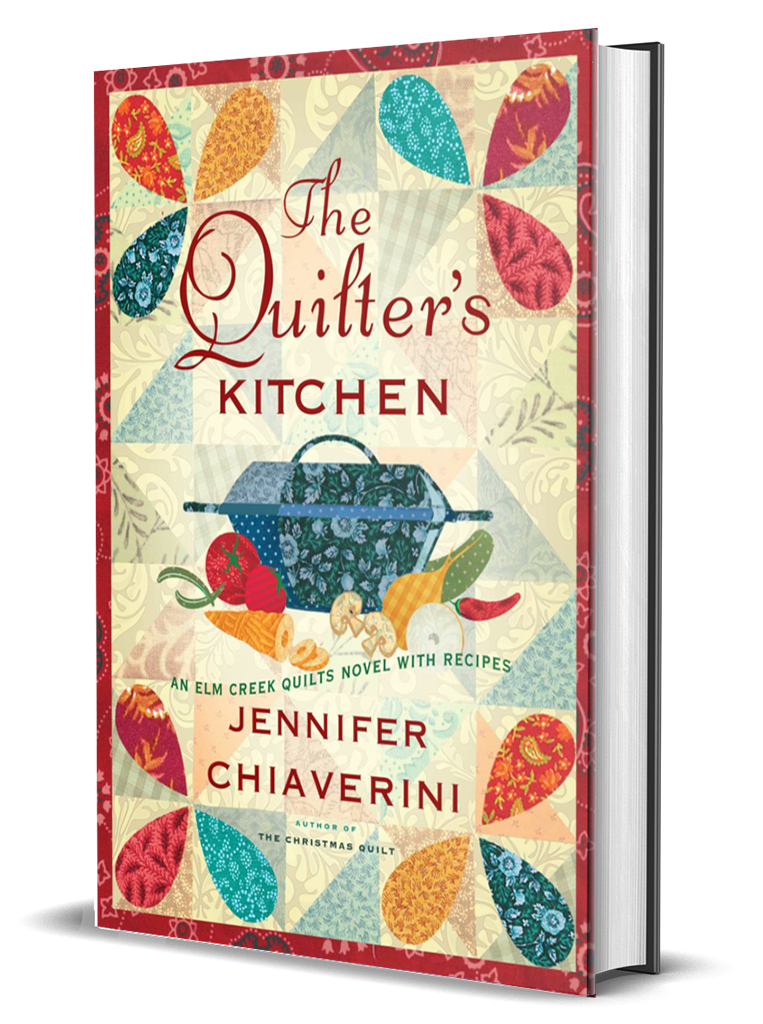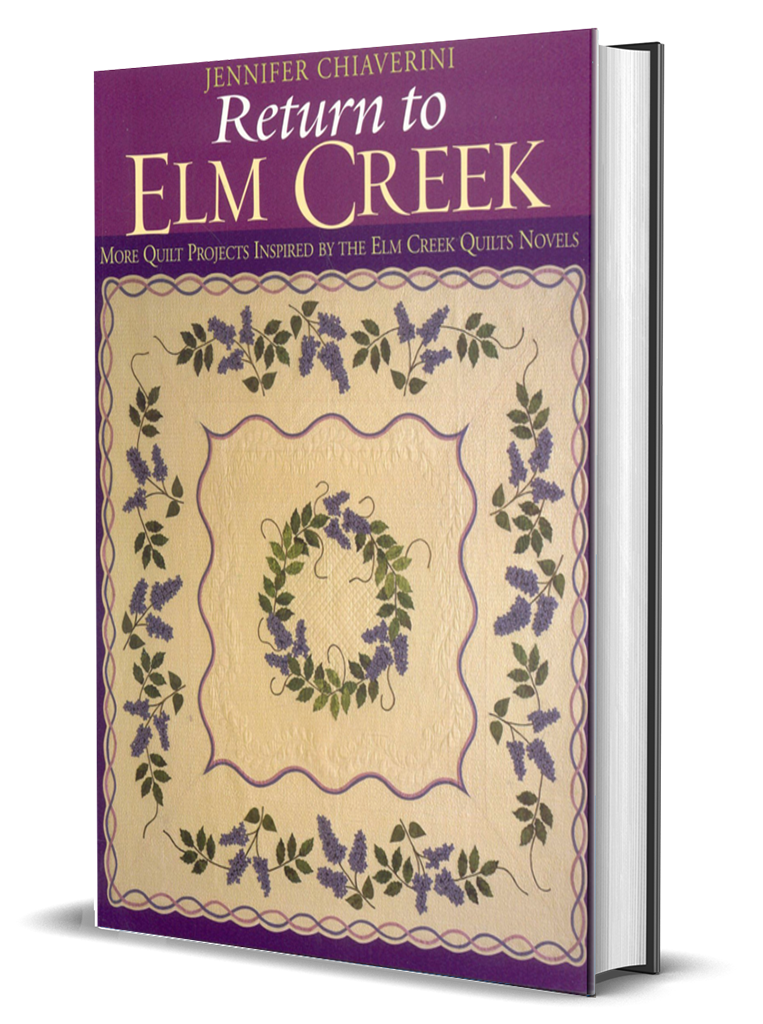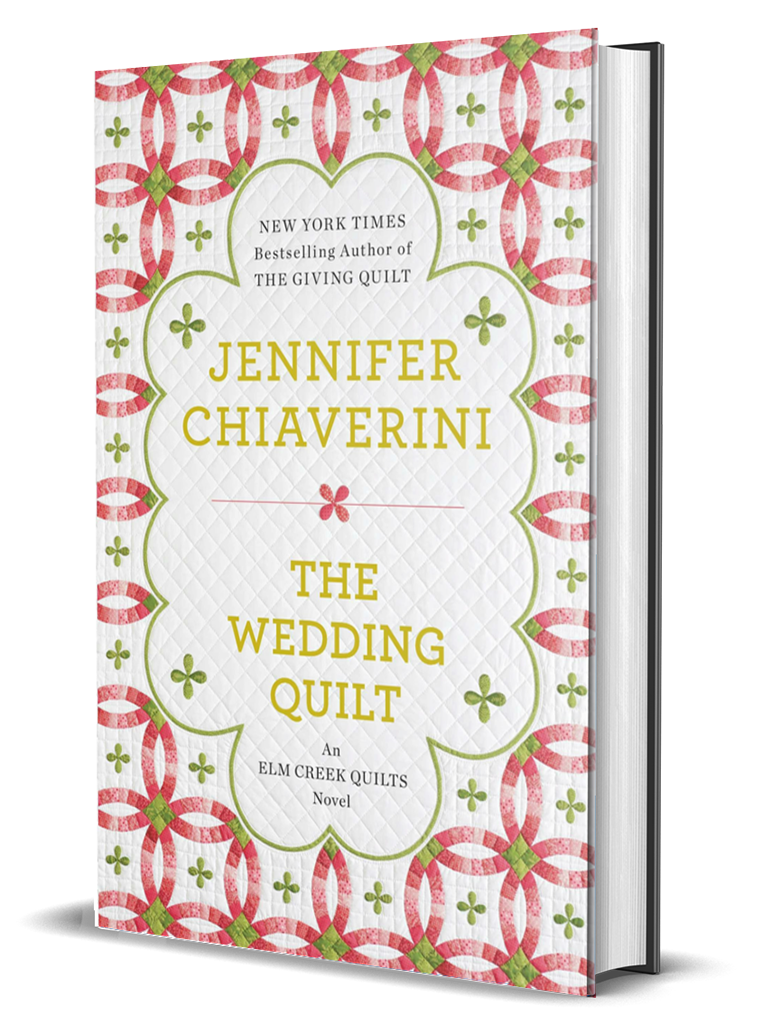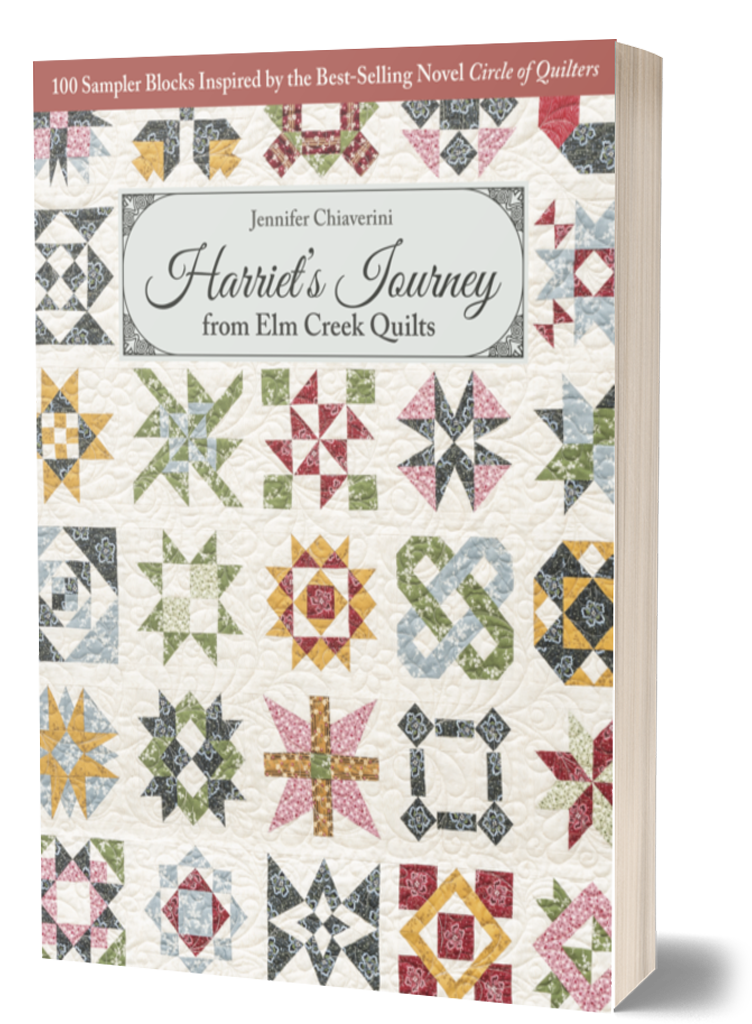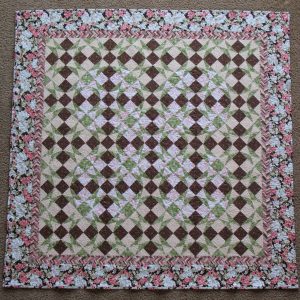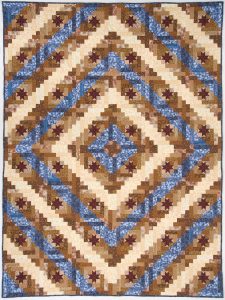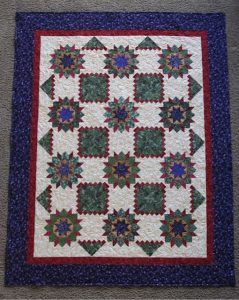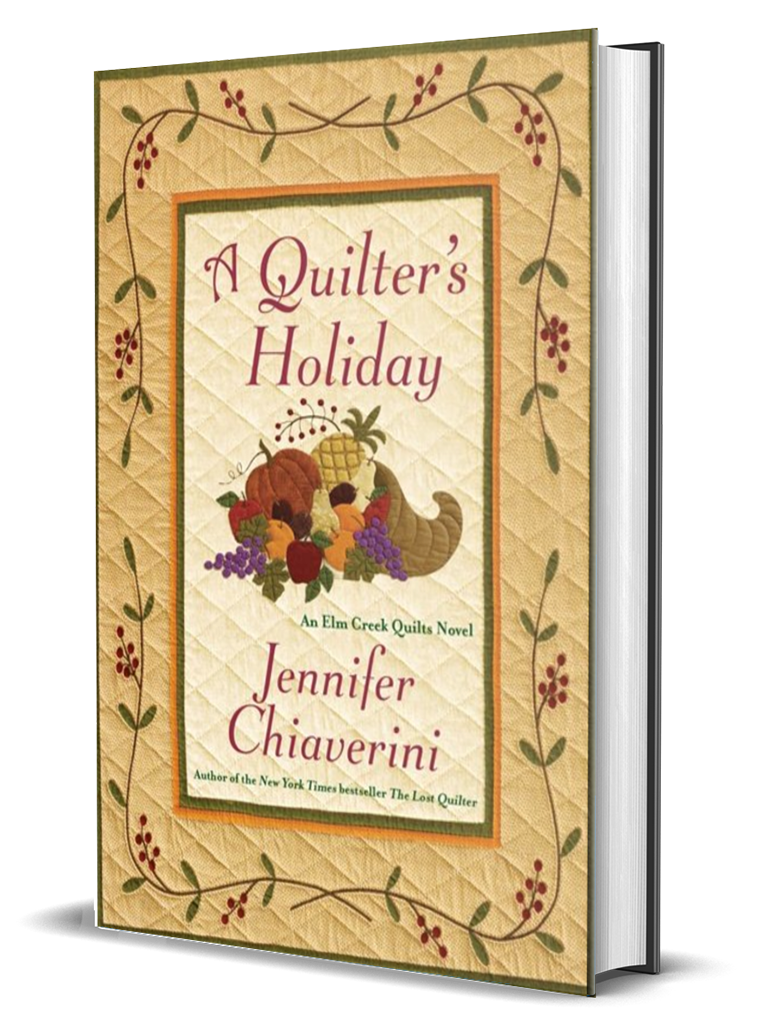
A Quilter’s Holiday
“Longtime fans of the series will learn more of the quilters’ backstories and get delightful hints of what will follow in subsequent novels. A must for series fans.” — Judy Coon, Booklist
For the Elm Creek Quilters, the day after Thanksgiving marks the start of the quilting season, a time to gather at Elm Creek Manor and spend the day stitching holiday gifts for loved ones. This year, in keeping with the season’s spirit of gratitude, Master Quilter Sylvia Bergstrom Compson Cooper is eager to revive a cherished family tradition. A recent remodeling of the manor’s kitchen unearthed a cornucopia that once served as the centerpiece of the Bergstrom family’s holiday table. Into it, each Bergstrom would place an object that symbolized something he or she was especially thankful for that year. On this quilter’s holiday, Sylvia has invited her friends to continue the tradition by sewing quilt blocks that represent their thankfulness and gratitude.
As each quilter explains the significance of her carefully chosen block, stories emerge of love and longing for family and friends, feelings also expressed in the gifts they work upon throughout the day. Diane is thankful for her two sons, who’ve outgrown their youthful troubles into fine young men, but she wishes they cherished their family traditions as much as she does. Anna, in her first holiday season as an Elm Creek Quilter, creates a quilt for her best friend, even as she begins to question her feelings for him, which may have grown beyond friendship. Sylvia reflects upon holidays past spent with her beloved, long-lost cousin Elizabeth and wonders whatever became of her. Sarah, pregnant with twins, determinedly sews a Christmas gift for her father-in-law, whose persistence that Matt come to work for his construction company has created tension in their marriage. And as Gretchen pieces a quilt for a charity she has not yet chosen and Gwen completes a project begun by her graduate school mentor, both women lend their talents to those in need.
As an early winter storm blankets Elm Creek Manor in heavy snow, each quilter finds new meaning in their cherished traditions, and more than one finds new reason to be thankful. A Quilter’s Holiday is a story of holiday spirit, in its truest, most generous sense.
Praise for A Quilter’s Holiday
Read an Excerpt from A Quilter’s Holiday
Chapter One: Sarah
On the day after Thanksgiving, Sarah woke to discover her unborn twins apparently engaged in an in utero kickboxing match to the accompaniment of her growling stomach. Propping herself up on one elbow, she reached for the crackers her husband had left on her nightstand beside a glass of water. She gently stroked her abdomen as she nibbled, taking care not to drop crumbs on the bed, and thought about the busy day full of friendship and fun awaiting her. It would be a quilter’s holiday at Elm Creek Manor, and as soon as Sarah satisfied her hunger pangs, she would drag herself out of bed and seize the day.
“Morning,” Matt said sleepily, rolling over to kiss her cheek and then her tummy, twice. His curly blond hair was flattened against his head on one side and his brown eyes were still half-closed. “Honey, I’ve been thinking…”
“How have you had time to think? You just woke up.”
“I’ve been awake for awhile, lying here watching you nibble your crackers.”
Sarah held out a saltine. “Want one?”
“No thanks. I’ll wait to see what Chef Anna’s fixing for breakfast. Yesterday Jeremy mentioned that he was going to drop her off early on his way to Chicago.”
“I’m afraid you’re on your own.” Sarah carefully sat up against the headboard, drew her long, reddish-brown hair over one shoulder, and muffled a grunt as she leaned over for the glass of water. “Jeremy isn’t dropping Anna off so she can make breakfast. Sylvia insisted she take the morning off.”
“After preparing that Thanksgiving feast yesterday, she deserves a day of rest.”
Sarah sighed happily, remembering. Although she had toasted the holiday with ginger ale rather than the California cabernet sauvignon her friends and family had enjoyed, for the first time in her adult life, she had indulged in a Thanksgiving feast without giving calories a second thought. “I’m eating for three,” she had responded cheerfully when her mother cautioned her against taking such generous helpings of Chef Anna’s succulent roast turkey and savory cranberry cornbread dressing. Green beans and butternut squash had never seemed more flavorful, and best of all, she didn’t have to choose between pumpkin pie and apple cake for dessert but took modest slices of both.
“Matt’s going to have to roll you upstairs to bed tonight,” her mother had remarked. “You won’t need to eat for a week.” Carol had gained only twenty pounds in her pregnancy, or so she claimed, but Sarah had left that number behind long ago.
“Anna earned the time off,” Sarah agreed, “so it’s oatmeal or cereal for you this morning, honey.”
“I’ll make up for it at the potluck lunch.” Matt propped himself up on his elbows, motioned for her to scoot forward, and slipped his pillow between her back and the cold brass bars of the headboard. “Husbands are allowed at the feast, right? Even though we aren’t participating in the quilting bee?”
Sarah smiled, but her gaze traveled past Matt to the window, where the light peeking below the curtains was thin and November gray. The weather forecast was for snow, but not enough to keep her friends away. “You know the rule. Everyone who brings a dish to pass will have a place at the table, quilter or not.”
That wasn’t the only rule defining the Elm Creek Quilters’ post-Thanksgiving tradition. On the Friday after Thanksgiving, while others throughout their rural central Pennsylvania valley were sleeping in or launching the Christmas shopping season, their circle of quilters would gather at the manor for a marathon of quilting to work upon holiday gifts or decorations. At noon they would break for a potluck lunch of dishes made from leftovers from their family feasts the previous day. Agnes, Sylvia’s sister-in-law, called their dinner a “Patchwork Potluck” and said the meal befit quilters, whose frugality inspired them to find creative uses for leftover turkey, stuffing and vegetables just as they created beautiful and useful works of art from scraps of fabric.
Matt rolled onto his back, tucking his hands beneath his head. “Do you think I can get away with bringing the leftover rolls as my dish, even though that wouldn’t involve any actual cooking?”
“That’s a step up from the bowl of corn you reheated in the microwave last year, so I’m going to say yes.”
“Watch it, sweetheart, or I’ll say something I’ll regret about how we’re lucky there are any leftovers to work with, the way you kept cleaning your plate.”
“You sound like my mother.” Usually that rebuke brought a swift end to Matt’s criticism, whether it was in jest or in argument. “I’m eating for three, remember?”
Matt held his hands apart about six inches. “Yes, but two of you are only this big.
If you were feeding yourself and a pair of three-year-olds, I could understand the need for five helpings, but since it’s one woman in her thirties and two fetuses in their sixth month—”
“Five helpings?” Sarah protested. “I stopped at thirds.”
“Three helpings of dinner plus two of dessert equals five plate-cleanings.” Then Matt seemed to think better of proving his point. “But you ate healthy food and you’re taking great care of little Barnum and Bailey. They’re lucky to have you for a mother.”
Sarah laughed. “Barnum and Bailey?”
Matt grinned up at her. “Why not?”
They didn’t know whether the twins were boys or girls or one of each, and they didn’t want to know until the moment the babies were born. Most of their friends understood and respected their decision, but some of the Elm Creek Quilters hoped they would change their minds because, they said, it would be easier to make quilts and other gifts if they knew whether the babies were girls or boys. Diane was the most persistent in her complaints, as she was about most things. She was certain that Sarah and Matt had glimpsed the truth during one of Sarah’s ultrasounds but were concealing the secret just to be contrary, so she scrutinized the couple’s words and actions for clues to the truth. If Sarah preferred a pink fabric for a new quilt project, Diane triumphantly declared that the babies were surely girls. If Matt referred to one of the twins as “he” because “he or she” became annoying after frequent repetition and he hated to refer to one of his children as “it,” Diane gleefully teased him about giving away the secret. Always ready to give as good as he got, Matt began calling the babies various paired names, usually nonsensical names that amused Sarah and drove Diane crazy. Sarah’s favorites included “Sugar and Spice,” “Zig and Zag,” “Needle and Thread,” and “Bagel and Schmear.” The joke became even funnier when Carol began to worry aloud that Sarah and Matt might seriously consider one of those alarming combinations. Perhaps she was right to worry. Maybe it was the hormones, but Sarah thought “Barnum and Bailey” had possibilities.
“Well, this ringmaster thinks it’s time to get this circus on the road.” Sarah picked cracker crumbs from her nightgown and threw back the covers. “I have to get started on my turkey tetrazzini.”
“Now?”
“I want to get as much prepared ahead of time before my friends show up.” Sarah’s stomach rumbled and one of the twins kicked. Apparently the crackers had made little impact. “But I guess it can wait until after breakfast.”
It was only later, after she had showered and dressed and returned to the bedroom to find the bed made and Matt absent that she realized she had not given him a chance to tell her what he had been thinking about upon waking.
Elm Creek Manor wasn’t the best place to raise children, Sarah reflected as she descended the oak staircase to the grand, three-story front foyer. The elegant balusters on staircase and balconies were too far apart for government safety standards and the gleaming black marble floor would offer a toddler unsteady footing and hard landings. Baby proofing would be a nightmare, but Matt assured her he would take care of everything. Sylvia Bergstrom Compson, master quilter and co-founder of Elm Creek Quilts, reminded Sarah that generations of Bergstrom children had safely reached adulthood on her family estate, but Sarah found that small comfort. Once upon a time lead paint had been acceptable and seat belts optional, and although countless numbers of children had escaped injury, Sarah had no intention of repeating past generations’ mistakes.
In many other important ways, Elm Creek Manor was an idyllic place to raise a family. The estate offered acres of forest to explore, a creek for wading, fishing, and tossing stones, a thriving orchard with trees to climb and apples to pluck, gardens for picnics and games of make-believe, and a broad expanse of lawn for running and playing, for crunching through fallen leaves in autumn and building snow forts in winter. Even when the manor, a quilters’ retreat throughout the spring and summer, was full of guests, there was plenty of room for playing hide-and-go seek and many private nooks for curling up with a book or paper and crayons. Most importantly, the manor was home to Sylvia and other dear friends who would offer the children unconditional love and affection, and what helped children thrive more than that?
She and Matt had so much to be thankful for in that season of Thanksgiving, Sarah thought as she crossed the foyer and turned down the older, west wing of the manor. Perhaps that was what he had wanted to tell her.
Appetizing aromas wafted down the hallway from the kitchen, lingering scents of cinnamon, nutmeg, and fresh-baked bread and something new that Sarah didn’t recall from their Thanksgiving feast. She found Anna Del Maso at the stove stirring something in a large copper stockpot, her long, dark-brown hair in a neat French braid, a crisp white apron tied about her neck and waist.
“What are you doing here so early?” asked Sarah. “You’re not supposed to be working today.”
“Don’t worry. I’m off the clock.” Anna threw her a quick smile over her shoulder. “The bus is running a limited schedule because of the holiday so Jeremy dropped me off on his way to Chicago.”
“He’s going to see Summer?”
Anna nodded and turned back to the stockpot. “She was too swamped with grad school work to come home for Thanksgiving, so he went to her.”
“I thought Gwen said she’d made plans with her roommates.”
“He’s her boyfriend, isn’t he? Wouldn’t he be welcome to join them?”
“I can’t speak for Summer’s roommates, but I can’t imagine why not.” Sarah watched a thin wisp of steam rise from the pot and inhaled deeply. “That smells wonderful.”
“It’s our soup course. Ginger pumpkin bisque.”
Sarah glanced into the pot at the simmering golden liquid as she took a paper sack of bagels from the breadbox. “Made with leftover pumpkin pie? Because I didn’t think there was any.”
Anna laughed. “No, not leftover pie. Leftover pumpkin that didn’t make it into the pie.” She set down her spoon, turned down the flame, and wiped her hands on her apron. “Would you mind keeping an eye on this while you have breakfast? I still have a few more seams to go on my quilt block for the cornucopia. This is my first day-after-Thanksgiving as an Elm Creek Quilter and I want to get it right.”
Sarah nodded, but not without misgivings. No matter how often Anna assured her that she was a fine cook, Sarah was reluctant to risk ruining one of the talented chef’s marvelous culinary creations. “The quilt-block cornucopia is new to all of us,” she reminded Anna. “I don’t think you can go wrong.”
Anna smiled as she untied her apron, the dimple in her right cheek deepening and a sparkle lighting up her dark brown eyes. Sarah knew Anna considered herself too plump to be pretty, and she often wondered how her friend could be so blind to her own beauty. “Even so, I’m not leaving that up to chance. You Elm Creek Quilters set high standards.”
“You mean we Elm Creek Quilters set high standards,” Sarah called after her as Anna left the kitchen. Too often Anna forgot to include herself when she spoke of them, though as far as Sarah was concerned, she was no less a member of their circle than the founding members. Sarah hoped Anna would begin to feel less like an outsider as the Elm Creek Quilters forged new traditions, such as this one, inspired by a discovery Anna and Sylvia had made while remodeling the kitchen a few weeks before.
The west wing of Elm Creek Manor had been built in 1858, and when Anna was offered the chef’s job in August, she couldn’t hide her concern regarding its condition. Sarah didn’t have to be a professional chef to understand her dismay. Not a single appliance was post-1945 except for a tiny microwave on the counter, possibly the first ever invented by the look of it. Poor lighting, battered utensils, broken stovetop burners—the list of necessary repairs went on and on. The Elm Creek Quilters had managed to feed an entire quilt camp three meals a day by adapting to what Sylvia referred to as the kitchen’s “charming quirks,” but none of them expected someone with Anna’s experience to endure such conditions happily, and none was surprised when she made the promise of a total remodel a condition for accepting the post. Fortunately, Sylvia agreed that drastic improvements were long overdue, so after the camp season ended, contractors transformed the kitchen by knocking out a wall and expanding into an adjacent sitting room, then hauling away the old appliances, counters, and cabinetry, and replacing them with everything on Anna’s wish list. Privately Anna had confided to Sarah that she had not expected Sylvia to do half of what she had requested and she would have settled for less. Sarah had laughed and had told Anna that as she would soon discover, Sylvia never did anything by half measures.
Before the contractors could begin, Sylvia and Anna had been obliged to clear every cabinet, cupboard, drawer, and pantry shelf, sorting useful items from clutter that should have been discarded long ago. As they worked, they discovered cherished Bergstrom family heirlooms—an old gingham table cloth, a great-aunt’s collection of feedsack cloth aprons, Sylvia’s mother’s favorite cut glass serving dish—and a Thanksgiving cornucopia Sylvia’s sister, Claudia, had woven of straw as a schoolgirl.
As Sylvia told it, the cornucopia, dilapidated from years buried under a pile of tablecloths in the back of a cupboard, had been the centerpiece of the Bergstrom Thanksgiving table every year from the time Claudia brought it home from school. When the Bergstroms gathered for our holiday feast, each member of the family placed something in the cornucopia—a small object, a drawing, a letter, anything small enough to fit inside would do as long as it represented what they were most thankful for that year. Sylvia’s mother always placed a picture of her family inside the centerpiece, while Sylvia’s father had usually selected something like an apple or a horseshoe to signify the abundance of their farm. The children’s choices were often more amusing if no less heartfelt—trinkets, toys—but everyone from the youngest toddler to the eldest grandparent added something. After the meal, the family removed the items from the cornucopia one by one as the person who had chosen it explained what it symbolized and what they were most grateful for that year.
Upon discovering her late sister’s long forgotten craft, Sylvia had been inspired to revive the tradition, but with an important change appropriate for a gathering of quilters. Where the Bergstroms had used pictures, letters, or small trinkets, the Elm Creek Quilters would create quilt blocks, each stitching one that either by name or imagery represented something for which she wished to give thanks. As they enjoyed their Patchwork Potluck, they would share their stories of gratitude, the inspiration for their handiwork.
For Sarah there had only been one possible choice.
Sarah finished her breakfast and started putting together her perennial contribution to the potluck, turkey tetrazzini, occasionally stirring Anna’s pumpkin ginger bisque and glancing out the window over the sink to the back parking lot for the arrival of her friends. She was grating the mozzarella when Gretchen entered, her black cardigan buttoned over a crisp white blouse, the formality of her plum corduroy skirt offset by her comfortable fleece slippers, their size exaggerated by her thin ankles. “Nothing that smells so yummy could possibly be made from leftovers,” Gretchen exclaimed, savoring the aroma. “Is Anna here?”
“Of course. You don’t think I’m responsible for something so complicated as pumpkin ginger bisque, do you?”
“I’m sure you could whip up something just as tasty if you had the recipe,” said Gretchen loyally, opening the refrigerator. She was in her mid-sixties, with steel-gray hair cut in a pageboy and a thin frame that Sarah thought seemed chiseled thin by hard times. Still, Sarah had noticed that Gretchen’s careworn look had improved considerably since she had accepted the teaching position with Elm Creek Quilts and had moved into the manor with her husband. Joe, who endured lingering effects from a serious injury he had suffered years before as a steelworker in Ambridge, enjoyed restoring antique furniture in the woodshop he had set up in the barn and occasionally assisted Matt with his caretaker’s duties.
“It would take more than a recipe or an entire collection of recipes to put me in Anna’s league,” said Sarah, filling a pot with water, setting it on a back burner, and turning on the flame.
“It’s true that Anna has a gift.” Gretchen searched through the refrigerator, taking out plastic containers and lifting the lids to check the contents. “I’ve been feeling quite spoiled ever since I came to live here, having so many of my meals prepared by a professional chef. You weren’t going to use the leftover green beans and dressing, were you? I thought I’d make a three-bean casserole.”
“Mmm, sounds yummy. They’re all yours.” Sarah thought wistfully of Summer, a vegetarian, who often brought a three-bean salad to their potlucks but would not be joining them for the first time since they had begun their day-after-Thanksgiving tradition. Summer was closest to Sarah in age of all the original Elm Creek Quilters and her best friend among them except for Sylvia, who would always hold a unique place in Sarah’s heart. Probably the only Elm Creek Quilter who missed Summer more was Gwen, her mother.
Sarah kept her ears tuned for the sound of cars approaching as she and Gretchen worked on their dishes. After a few moments, Gretchen broke the silence by saying absently, “I wonder what everyone else will contribute?”
“Gwen will bring a dessert because she always does,” said Sarah, draining the cooked pasta in a colander in the sink. “Diane will bring something healthy or something that looks suspiciously new, and then she and Gwen will spend ten minutes debating what percentage of the dish has to be leftovers in order for it to meet the requirements.”
Gretchen smiled as if she had no doubt Sarah’s predictions would prove true. “I was thinking aloud,” she said. “I should have been more clear. I was wondering what quilt blocks everyone has made for the cornucopia, and what they’re most thankful for. I had so much to be grateful for this year I had a difficult time choosing only one. And that, I think, is the sign of a very good year.”
Sarah agreed, but privately she wondered if Gretchen’s trouble selecting a single quilt block said more about her indomitable spirit and appreciation of life’s simplest gifts than about the year.
One by one, the residents of Elm Creek Manor came to the kitchen for breakfast and to prepare their contributions for the potluck. Sylvia put together a casserole from the leftover butternut squash and cranberry cornbread dressing, which she promised tasted much better than it sounded, and then left to take freshly washed linens from the laundry room to the banquet hall. Sarah’s mother, Carol, who was visiting for the holiday, delighted Sarah by using leftover sweet potatoes to prepare one of her grandmother’s favorite recipes, a baked dish of sweet potatoes, apples, and cranberries. Matt stopped by on his way in from the barn for a quick breakfast of cereal, a bagel, and coffee, as well as to hide the leftover rolls in the back of the pantry so that no one else would claim them.
Sarah found him in the back hallway as he was putting on his coat and gloves before returning to work. “What was it you wanted to tell me this morning, honey?”
Matt frowned thoughtfully as he laced up his sturdy boots. “What do you mean?”
“This morning, in bed. You said, ‘You know what I was thinking?’ You never told me.”
“Oh, that. It was nothing.”
She caught him by the sleeve as he opened the back door. “It must have been something.”
Matt hesitated and ran his gloved hand over his jaw. “I was thinking about growing a beard. What do you think?”
Sarah folded her arms and studied his stubble, blond flecked with red. “I think you might look like a mountain man, but it’s your face.”
“True, but you’re the one who’ll have to look at it.”
She reached up to place her right hand on his left cheek. “Bearded or clean-shaven, there’s no face I’d rather see every day for the rest of my life.”
“Wow.” Matt paused as if stunned. “The most I was hoping for was, ‘You can always shave it off if you don’t like it.’”
“Sometimes in life you get more than you hoped for.”
“That’s only fair, because too often you get less.”
She drew her hand away. “What do you mean?”
“Nothing.” He grinned and kissed her. “Save me a seat beside you at lunch, okay?”
She agreed and closed the door behind him after he left, troubled. Something more than a beard weighed on his mind, but he clearly no longer wanted to discuss it. Maybe later she could catch him at a more forthcoming moment, but in the meantime… She would try not to worry.
She returned to the kitchen. Andrew, Sylvia’s husband, who had cooked for himself for years after his first wife’s death but nonetheless seemed ill at ease in Anna’s spotless, modern kitchen, stood with his hand on the refrigerator door studying the contents so apprehensively that Sarah was moved to assure him that he could consider the remaining bottles of wine and sparkling cider his contribution to the potluck.
Relieved, Andrew accepted the offer. “I thought I’d have to go hungry,” he confessed. “Matt told me the rules.”
“We’d make an exception for you,” said Sarah. “But don’t tell Matt.”
“You still have time to make a block for the cornucopia too,” remarked Carol as she deftly cut the peel from an apple in one long, shiny, red strip. She had finished her block late the night before, but not without chiding Sarah for not informing her of the ritual sooner. Sarah hadn’t thought to tell her. Her mother was only a novice quilter, not that her beginner’s status would have excluded her, but it hadn’t occurred to Sarah that her mother might want to participate.
“I’ll stick to bringing the drinks and admiring the quilt blocks you ladies make,” said Andrew. He poured coffee into a thermos and said he’d be out in the woodlot cutting logs if anyone needed him.
“He is an absolute gem,” Carol declared after he had gone. “Sylvia’s lucky to have him.”
“I think their luck is mutual,” said Gretchen, and they all agreed. Sylvia and Andrew had known each other since childhood, but their lives had taken them down different paths. They had reunited decades later after each had lost a beloved spouse, never expecting that they would fall in love and marry.
It was not quite nine o’clock when Gwen’s hybrid pulled into the parking lot. Within minutes they heard the back door to the manor open and close, followed by a bustle of boots and coats in the hall closet. Then Gwen appeared in the doorway carrying a glass cake pan covered in foil, her cheeks rosy from the cold, her long, wavy, auburn hair streaked with gray, a quilted knapsack on her back. “Did you hear the forecast?” she greeted them cheerfully, setting the pan on the counter. “We’re expected to get hit with a nor’easter today.”
“What?” exclaimed Sarah. “The last I heard, we were only expected to get some light snow showers.”
“How much snow are they predicting?” asked Sylvia, returning from her errand to the laundry room and banquet hall, her arms full of freshly washed dish towels.
“Ten to twelve inches,” said Gwen, strolling through the kitchen to peek at her friends’ creations. “We all might have to spend the night.”
“With quilt camp closed for the season, we have plenty of rooms,” said Sarah, settling into a booth in the breakfast nook with a cup of decaf coffee. “As long as everyone makes it to the manor before the storm hits, it shouldn’t spoil our plans. We could have an all-night quilt marathon like the old days.”
“The front isn’t supposed to reach our county until this afternoon,” said Gwen, apparently the only among them who had spared time for the news that morning. “It was over Ohio last time I saw the weather radar.”
“I hope Jeremy doesn’t get stuck on the interstate,” said Anna, who had returned to the kitchen smiling and lost in her own thoughts, but whose smile faltered when she heard the updated forecast. “He’s probably near Cleveland right about now.”
“I’m sure he’ll be fine,” said Sylvia. “He’s a resourceful young man, and smart enough to know when he should pull off the road rather than press on.”
“Maybe usually,” Anna murmured, and she looked no less worried as she put on a fresh pot of coffee and filled the kettle for tea.
The manor’s permanent residents finished preparing for the potluck lunch and were tidying the kitchen when the last two Elm Creek Quilters arrived together, the taller, younger Diane driving petite white-haired Agnes, as was their longtime custom. Blond, enviably slender Diane was the mother of two sons in college, although she didn’t look it. “Make way for the main course,” she warned as she entered the kitchen, still clad in her tailored red wool coat and black leather gloves and carrying a large white casserole dish with a glass lid.
“Hold on,” said Gwen, her beaded necklaces clinking softly as she put her head to one side, studying the casserole dish, which thudded heavily when Diane set it on the counter. “A main course means effort. You just dumped a bag of frozen veggies in there and stirred in a can of cream of mushroom soup, didn’t you?”
“Shut it, hippie,” said Diane breezily, taking off her gloves and tucking them into her coat pockets. “This is Agnes’s deep dish turkey pie. We swapped. She’s carrying my cinnamon bread. It’s lighter.”
“One would hope so,” said Gwen.
Just then, Agnes, who had paused to leave her winter garb in the hall closet, entered the kitchen. “Good morning, everyone!” She set a plastic bag holding a round loaf of marbled bread on the counter beside the casserole. “Who’s ready for a quilter’s holiday feast?”
As the others happily chimed in that they were ready, Gwen studied the bread skeptically. “Did you stop at the bakery on your way in? That’s cheating.”
“Of course not, Gwen,” chided Agnes, her blue eyes mild behind pink-tinted glasses.
“See? I have a witness,” Diane retorted over her shoulder as she left the kitchen to put away her coat and boots. “I made it in my bread machine this morning.”
“Well, to be fair,” said Agnes, glancing after her, “I can only verify that we didn’t stop at the bakery on the way. I didn’t witness any actual baking.”
“I’m sure we can take Diane’s word for it,” said Gretchen just as Diane returned.
“You don’t know her as well as we do,” said Gwen. “Tell us, Diane. Exactly what part of this bread qualifies as a leftover?”
“Almost all of it,” said Diane, searching the cupboards for her favorite coffee mug. “The flour, the salt, the cinnamon—I bought every ingredient for other recipes.”
Gwen shook her head. “Kitchen staples aren’t the same as leftovers.”
“I didn’t use them up earlier, and therefore, they’re left over.” Diane filled the large pink cappuccino mug with coffee and sipped it, black. “Anyway, I have two young men home from college. It’s a Thanksgiving miracle I have any food left in the house.”
Suddenly Gwen turned wistful, and Sarah knew she was thinking of her daughter, Summer, hundreds of miles away at the University of Chicago. “Now, that’s a problem I’d like to have.”
Diane eyed her over the rim of her coffee mug. “You’d like to have two young men home from college in your house? Why, Gwen, this is a side of you I haven’t seen before.”
“Shut it, cheater,” said Gwen.
Before Diane could argue that she hadn’t cheated, Sylvia stepped in and suggested they coordinate the cooking and reheating times and temperatures for their assorted dishes so that everything would be ready to serve as close to the same time as they could manage. Anna took charge and quickly wrote up a schedule, and with the kitchen details sorted out, the Elm Creek Quilters gathered their supplies and reconvened in the ballroom to begin their daylong quilting marathon.
The ballroom took up almost the entire first floor of the south wing of the manor, added on to the original home in the early nineteen hundreds after the Bergstrom family had made its fortune raising champion horses. A carpeted border roughly twenty feet wide encircled the broad parquet dance floor, most of which was subdivided into classrooms by tall, white, moveable partitions. Three crystal chandeliers hung high above from a ceiling covered with a swirling vine pattern of molded plaster. A dais on the far side of the room served as a stage from which teachers could offer a seminar to the entire camp at once or where musicians or other performers entertained the campers during evening programs. On the opposite wall was a large fireplace flanked by a rack of fire tools and a newly filled log holder, evidence of Andrew’s hard work. Ever thoughtful, he had arranged chairs nearby and had laid a fire for them, awaiting only the touch of a match. Tall, narrow windows topped by semicircular curves lined the south, east, and west walls. The heavy drapes had been drawn back, and through the glass Sarah saw a few large, white flakes swirling in a light wind.
Though the ballroom was too grand and vast to be called intimate, it was the perfect place for the Elm Creek Quilters to spend a day quilting. The classrooms provided every quilting tool or notion they could possibly need, from sewing machines to irons to rotary cutters and mats, and the chairs pulled up to the fireplace gave them the sense of warmth and coziness. Earlier, Matt had rolled wheeled worktables from the classroom area closer to the fireside and had set up workstations for cutting fabric, sewing, and ironing so that no one would have to venture far from the camaraderie and conversation to attend to those tasks. Fortified by coffee or tea, mindful of the time and tasks remaining in the kitchen, the quilters settled down to work, threading needles and unfolding fabric, arranging quilt blocks on the parquet dance floor and admiring one another’s projects.
“There’s no better way to kick off the quilting season than with a quilter’s holiday,” said Diane with a satisfied sigh as she settled back into an armchair, propped her feet up on a padded stool, and paged through a holiday-themed craft magazine.
“The quilting season?” echoed Anna, searching through Sarah’s thread box for a shade of gold that more closely matched the scrap of fabric on her lap. “Isn’t it always the quilting season at Elm Creek Manor?”
“Of course, but the day after Thanksgiving marks the official start of the official quilting season.”
Gretchen looked dubious. “I’ve never heard of an official quilting season, and I’ve been quilting for a very long time.”
“It’s only official in Diane’s mind,” said Gwen. “She’s lobbied the National Quilter’s Association to have it declared a holiday, but to no avail.”
“I have not,” retorted Diane, but she looked as if she thought it might be a good idea.
Gwen threaded a needle with a long strand of cream-colored thread. “Then stop tossing around the word ‘official’ like it means something.”
Sarah glanced up in surprise from arranging patchwork blocks on the parquet floor. She had become accustomed to the banter between Gwen and Diane, but Gwen seemed relentless in her pursuit of a conflict that morning.
“We all miss Summer,” said Sylvia, pinning a forest green rhombus to a mirror image piece cut from scarlet. “And Bonnie, and Judy, and all our friends who couldn’t be here today. But of course, Gwen, we understand that the absence of a daughter aches more keenly.”
“What’s she’s trying to say is that we understand why you’re so grumpy, but stop taking your bad mood out on me,” said Diane, rolling up her magazine, “or I’ll be forced to swat you.”
“Your kind always resorts to threats of violence in the end,” said Gwen, but she allowed a small smile.
“Official or not, this does feel like the start of the quilting season,” remarked Agnes, and all, even Gwen, agreed. Although quilters pieced and sewed throughout the year, when the weather turned colder and forced them indoors, it especially appealed to a quilter to layer a quilt sandwich in a lap hoop, curl up on the sofa, and snuggle beneath the soft folds. While the winds blew and snow fell, they could enjoy the comforting softness and stimulating color of fabric as they cut and sewed and created objects of warmth and beauty for those they loved. The arrival of the day after Thanksgiving also meant that the Elm Creek Quilters had about a month left to complete all the quilts, table runners, garments, ornaments, and other quilted items they intended to give as Christmas gifts. A day devoted to quilting in the company of friends, free of other distractions, would allow them to make good progress on their homemade gifts—and hold off the frenzy of the holiday season one day more.


